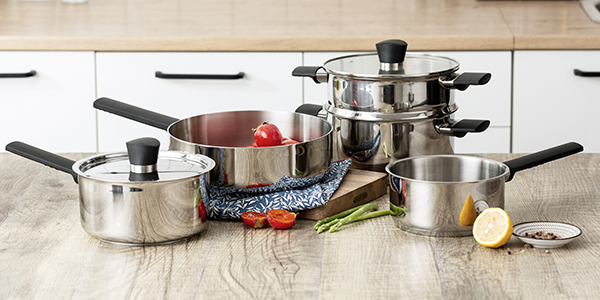NF Cookware Certification guarantees safe and efficient cookware

With so many products available how do you choose, which pan, saucepan or frying pan to buy?
A new certification standard from NF Cookware helps you to see more clearly!
Why choose NF certified cookware?
NF COOKWARE CERTIFICATION IS DELIVERED BY SGS FRANCE, AN INDEPENDENT CERTIFICATION ORGANIZATION.
We test and verify the performance and durability of products to bring you safer and more compliant items. In other words, by selecting an certified NF cookware you are choosing:
- A safer, more reliable and more durable product that meets current regulatory requirements as well as French and European standards
- An article verified and controlled by SGS France according to specifications defined and validated by market players and AFNOR Certification
- A more efficient product tested under rigorous conditions of use to best meet your needs.
Whether it is a frying pan, saucepan, pan, wok, cooking pot or crepe pan: NF Cookware certification guarantees the product you choose.

What is NF certification?
It belongs to AFNOR (Association Française de NORmalisation). SGS France is mandated by AFNOR Certification to issue this mark in order to guarantee the quality and reliability of your cookware.
Want to know more about the standard?
Find out everything about the certification process, applicable standards, laboratory tests and quality controls, the terms of use of the NF mark, commitments with respect to the standard.
NF Cookware certificationOur laboratory TESTS
All product tests (materials, mechanical tests, etc.) are carried out in our Aix-en-Provence laboratory by specialized technical teams.
If the products tested meet the requirements defined in the specifications, they are then certified NF Cookware.
HERE IS A NON-EXHAUSTIVE LIST OF TESTS CARRIED OUT BY OUR EXPERTS ON THE PRODUCTS:

Heating performance
We carry out tests to control the time it takes for the temperature of an article to rise, for example, how long it will take 1L of water will boil, or the uniformity of the temperature of the heating surface, to ensure it cooks evenly.

Combustion resistance
Does your hob run on gas? Do you sometimes shift your cooking utensil slightly without noticing that the handle is approaching the flame? We make sure that the handles of the products do not melt or catch fire.

Handles resistance
We test the resistance of handles with torsion, bending and lift / pose cycle tests with weight in the product, to ensure its sturdiness. For removable handles, we simulate opening and closing cycles to check their reliability over time.

Coating performance
Using the green (scouring) part of a basic sponge, we will check that the coating of your container (pan, saucepan, etc.) retains its non-stick properties over time.

Compatibility of heating surfaces
We check that the item is compatible with the declared heating source (gas, induction, electric). For the product to be compatible, no deformation must appear during hot and cold switching.

Thermal risks and burns
We check the heating of components likely to be handled by users (cuffs, buttons, covers, etc.) to prevent any risk of burns during handling.
Our advice for use
Before first use
Wash and lightly oil the entire surface of the interior coating.
While cooking
Adjust the size of the fireplace and center your cooking utensil on the heat source so as not to damage the handle (or handle) and the coating.
ADVICES DEPENDING ON YOUR ENERGY SOURCE:
• On a gas fireplace: center the kitchen utensil on the fireplace to ensure product stability. For small items, line up the handle of the pan with one of the legs of the hob grid to prevent the pan from tipping back.
• On induction hob: make sure that your item has a ferromagnetic bottom. Then, choose the induction stove whose diameter most closely matches that of the bottom of the cookware.
ADVICES DEPENDING ON THE TYPOLOGY OF YOUR STOVE:
• Cooking in a pan coated with nonstick? Avoid overheating when empty in the maximum position as this may deteriorate the non-stick properties of the coating and deform the bottom. For any non-stick items, avoid metal utensils, especially those with sharp edges. Never use a wire whisk or knives.
• Do you cook in an uncoated stainless steel pan? Preferably use fats that are resistant to high temperatures.
TO KNOW:
• Cooking at high temperature is not recommended: it does not necessarily shorten cooking time and may adversely affect the nutritional qualities of food. It can also damage the non-stick coating.
• With the exception of frying and searing, we recommend cooking at medium temperature.
• Never heat fat to carbonization.
Maintenance
WHAT TO KNOW TO EXTEND THE LIFE AND PERFORMANCE OF YOUR PRODUCT:
• Let your kitchen utensil cool before cleaning.
• Give preference to hand washing, as dishwasher detergents contain substances which can be very aggressive and corrosive to aluminum parts.
• Non-stick coated items: Clean the inside and outside of your cookware with hot water, liquid detergent and a sponge.
• Items with a special induction stainless steel base: wipe it off after each wash. A "blue" or "yellow" coloring may appear. This is natural and not dangerous and can be removed using dishwashing liquid or a special stainless steel cleaner, possibly with the addition of lemon or vinegar. Use an abrasive sponge exclusively on the stainless steel base.
• Uncoated stainless steel items: food residue may get stuck. Mix water and a little washing up liquid or vinegar, pour it into your utensil, then heat for a few moments. Then let it soak for half an hour: the residue should come off easily afterwards.
Storage
If you need to stack non-stick items for storage, consider sliding fabric dividers between them to protect the coating.
